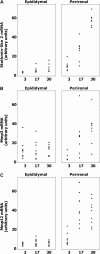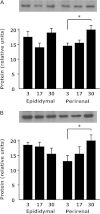Aging, depot origin, and preadipocyte gene expression
- PMID: 20106964
- PMCID: PMC2904595
- DOI: 10.1093/gerona/glp213
Aging, depot origin, and preadipocyte gene expression
Abstract
Fat distribution changes with aging. Inherent changes in fat cell progenitors may contribute because fat cells turn over throughout life. To define mechanisms, gene expression was profiled in preadipocytes cultured from epididymal and perirenal depots of young and old rats. 8.4% of probe sets differed significantly between depots, particularly developmental genes. Only 0.02% differed with aging, despite using less stringent criteria than for comparing depots. Twenty-five genes selected based on fold change with aging were analyzed in preadipocytes from additional young, middle-aged, and old animals by polymerase chain reaction. Thirteen changed significantly with aging, 13 among depots, and 9 with both. Genes involved in inflammation, stress, and differentiation changed with aging, as occurs in fat tissue. Age-related changes were greater in perirenal than epididymal preadipocytes, consistent with larger declines in replication and adipogenesis in perirenal preadipocytes. Thus, age-related changes in preadipocyte gene expression differ among depots, potentially contributing to fat redistribution and dysfunction.
Figures




Similar articles
-
Thiazolidinedione exposure increases the expression of uncoupling protein 1 in cultured human preadipocytes.Diabetes. 1998 Jan;47(1):138-41. doi: 10.2337/diab.47.1.138. Diabetes. 1998. PMID: 9421389
-
Increased TNFalpha and CCAAT/enhancer-binding protein homologous protein with aging predispose preadipocytes to resist adipogenesis.Am J Physiol Endocrinol Metab. 2007 Dec;293(6):E1810-9. doi: 10.1152/ajpendo.00295.2007. Epub 2007 Oct 2. Am J Physiol Endocrinol Metab. 2007. PMID: 17911345
-
Fat depot origin affects fatty acid handling in cultured rat and human preadipocytes.Am J Physiol Endocrinol Metab. 2001 Feb;280(2):E238-47. doi: 10.1152/ajpendo.2001.280.2.E238. Am J Physiol Endocrinol Metab. 2001. PMID: 11158926
-
Aging and regional differences in fat cell progenitors - a mini-review.Gerontology. 2011;57(1):66-75. doi: 10.1159/000279755. Epub 2010 Jan 29. Gerontology. 2011. PMID: 20110661 Free PMC article. Review.
-
Aging in adipocytes: potential impact of inherent, depot-specific mechanisms.Exp Gerontol. 2007 Jun;42(6):463-71. doi: 10.1016/j.exger.2007.03.003. Epub 2007 Mar 25. Exp Gerontol. 2007. PMID: 17507194 Free PMC article. Review.
Cited by
-
The Aging of Adipocytes Increases Expression of Pro-Inflammatory Cytokines Chronologically.Metabolites. 2021 May 1;11(5):292. doi: 10.3390/metabo11050292. Metabolites. 2021. PMID: 34062781 Free PMC article.
-
Proliferation of nutrition sensing preadipocytes upon short term HFD feeding.Adipocyte. 2019 Dec;8(1):16-25. doi: 10.1080/21623945.2018.1521229. Epub 2018 Sep 29. Adipocyte. 2019. PMID: 30269635 Free PMC article.
-
The Growth Hormone Receptor: Mechanism of Receptor Activation, Cell Signaling, and Physiological Aspects.Front Endocrinol (Lausanne). 2018 Feb 13;9:35. doi: 10.3389/fendo.2018.00035. eCollection 2018. Front Endocrinol (Lausanne). 2018. PMID: 29487568 Free PMC article. Review.
-
JAK inhibition alleviates the cellular senescence-associated secretory phenotype and frailty in old age.Proc Natl Acad Sci U S A. 2015 Nov 17;112(46):E6301-10. doi: 10.1073/pnas.1515386112. Epub 2015 Nov 2. Proc Natl Acad Sci U S A. 2015. PMID: 26578790 Free PMC article.
-
Targeting senescent cells enhances adipogenesis and metabolic function in old age.Elife. 2015 Dec 19;4:e12997. doi: 10.7554/eLife.12997. Elife. 2015. PMID: 26687007 Free PMC article.
References
-
- Kirkland JL, Corkey BE, Tchkonia T. Current views of the fat cell as an endocrine cell: lipotoxicity. Endocr Updat. 2006;26:105–118.
-
- Lakka HM, Laaksonen DE, Lakka TA, et al. The metabolic syndrome and total and cardiovascular disease mortality in middle-aged men. JAMA. 2002;288:2709–2716. - PubMed
-
- Rodriguez A, Muller DC, Engelhardt M, Andres R. Contribution of impaired glucose tolerance in subjects with the metabolic syndrome: Baltimore Longitudinal Study of Aging. Metabolism. 2005;54:542–547. - PubMed
-
- Spalding KL, Arner E, Westermark PO, et al. Dynamics of fat cell turnover in humans. Nature. 2008;453:783–787. - PubMed
Publication types
MeSH terms
Substances
Associated data
- Actions
Grants and funding
LinkOut - more resources
Full Text Sources
Other Literature Sources
Medical
Molecular Biology Databases

